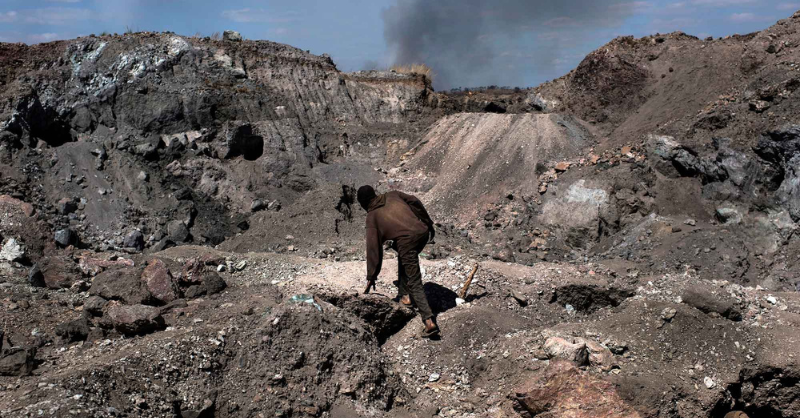
Bridging the gap 30.23
In case you missed it ...
Not a subscriber yet? Click here ('Bridging the gap' is free)
Here is a selection of recently published Quick Insights, Deep Dives or Perspectives that our subscribers get to read in full.
- Can the big miners fix artisanal mining? (Greener Energy Applications, Transitions / Human Rights)
- Only as strong as the weakest link in the supply chain (Transitions / Human Rights)
Plus a few from the archives:
- Greening ammonia - heat, pressure and hydrogen (Greener Energy Applications)
- The bees' needs (Agriculture / Natural Capital)
- Everything, everywhere, all at once - holistic approach to healthcare (Built Environment / Wellness)
What subscribers are reading this week
Can the big miners fix artisanal mining?
(Greener Energy Applications, Transitions / Human Rights, Premium and Professional)
Mining is a massive sustainability issue. We know we need more mining of certain minerals to allow the sustainability transitions to happen. We know we need mining to become more sustainable. How? Who takes the lead? We argue there is a really important role in this for all investors, both asset owners and asset managers.
Over the last few months, Rob Karpati, from The Blended Capital Group, has been guest writing blogs on artisanal mining - one of the tougher challenges in sustainability. One piece of feedback we frequently get from people who have read his writing is 'thanks, we now get the problem, so what can we do?'. This blog is about providing part of the answer. Formalisation is the preferred pathway, but how to best deliver it?
As with most sustainability topics, the real world answer is complicated. Governments have a clear role, as do NGOs and multilateral agencies, including providers of aid. They cannot do it on their own. In some cases government-led action has been patchy, and building consensus through multilateral agencies can be slow.
Another potentially big part of the solution is the involvement of the large scale miners. They obviously have the resources, and arguably they have the motivation. Yes, they cannot do it on their own but we argue they must be part of the solution. To make this happen we need to understand how the two groups interact, and how they can change this to their mutual benefit.
Link to blog 👇🏾


Only as strong as the weakest link in the supply chain
(Transitions / Human Rights, Professional)
Extensive and often complex supply chains lie at the heart of our current economic system. Stakeholders are increasingly considering the business as part of the broader ecosystem and are less inclined to absolve a business for 'sins of the connected.'
However many companies have limited knowledge of what happens upstream of their direct operations. The further one gets outside of an organisation into the value chain both upstream and downstream, the less control and assurance a business naturally has over activities, intermediary products, raw materials and unexpected events.
This is why governance is so important. Having strong policies, procedures and technology in place can help to provide a strong governance environment around a business's supply chain. Policies and procedures have been, and will continue to be important, but there are also technological innovations that could help. Traceability is a crucial component in guaranteeing provenance and sustainability through a supply chain. We discuss some examples of innovations there.
As important as having a strong governance environment around one's supply chain is how a business responds when supply chain disruption and issues happen, both operationally and from a communications perspective. The impact on value can be material, sometimes terminal.
Between 2008 and 2015, whilst working at Morgan Stanley, I was focused on the Asia markets, from India in the West to Australia and New Zealand in the East; from the ASEAN countries in the South to Mongolia and Japan in the North.
At the time, outsourcing was accelerating and the commodities supercycle was in full swing with rising demand from emerging markets and the BRIC countries (Brazil, Russia, India and China). This meant that supply chains grew rapidly and in many cases opaquely giving rise to a number of 'scandals' across different industries. From milk to shampoo to suitcases.
We'll start with a more recent example from late last year when simple cough medicine may have contributed to childhood deaths in Indonesia with the issues potentially arising from the pharmaceutical supply chain.
Link to blog 👇🏾

From the archives
Greening ammonia - heat, pressure and hydrogen
(Greener Energy Applications, Premium and Professional)
Germany's federal cabinet approved an updated national hydrogen strategy doubling the country's domestic electrolysis capacity target to at least 10 GW by 2030 and acknowledging the need to import 50% to 70% of its hydrogen demand by 2030.
Hydrogen is a decarbonisation problem in its own right given that almost all hydrogen is currently produced using fossil fuels. Around 43% of current hydrogen production is used to produce ammonia and more than 80% of ammonia production is used to produce fertilisers. The global production of ammonia has a direct CO2e footprint as big as Brazil's. It is twice as emissions intensive as crude steel production and four times that of cement. Making ammonia greener has many benefits.
We wrote about this in March in a Quick Insight looking at developments in this area.
Link to blog 👇🏾

The bees' needs
(Agriculture / Natural Capital, Professional)
Researchers from the University of the Sunshine Coast in Australia have identified a number of types of Australian high-grade propolis - used by honeybees to construct their hives with - containing more potent antioxidant activity than a number of established international types.
Propolis which contains bee saliva, beeswax and resin from plants that bees pollinate has been harvested in a number of countries including China, New Zealand and Brazil for years and is used in the food and cosmeceutical industries.
It has been used as a natural antibiotic for centuries but in recent years it has been found to also support (as an adjunct treatment) cancer therapies and some respiratory diseases.
Bees are important, but the commercialisation of honeybees, driven by the demise of many wild bee species, has led to increased exposure to a variety of diseases making the overall population even more vulnerable. Back in January we discussed the importance of bees following the approval of the world's first vaccine for honeybees against American foulbrood disease.
Link to blog 👇🏾

Everything, everywhere, all at once - holistic approach to healthcare
(Built Environment / Wellness, Professional)
The Health Foundation report on Health in 2040 projects that there will be 9.1 million people in England living with major illness by 2040 up almost 38% on 2019 and nine times the rate at which the working age population is expected to grow.
Most of this rise is the result of an ageing population and relates to conditions such as anxiety and depression, chronic pain and diabetes, which are predominantly managed in primary care and the community.
The report's authors comment that this "reinforces the need for investment in general practice and community-based services, focusing on prevention and early intervention to reduce the impact of illness and improve the quality of people’s lives."
The most common approach to healthcare in the west is an allopathic approach that focuses on treating specific symptoms or illnesses; in many eastern countries the approach is holistic which focuses on treating the whole person rather than just their illness or symptoms. We looked at those two approaches in more detail, some of their pros and cons and how a resultant focus on prevention (building resilience) can reduce the amount of treatment that is needed in a blog back in May.
Link to blog 👇🏾

Become a subscriber
Click here to joinPremium subscribers get to read in full...
- 'Quick Insights'
Designed to be short, easily digestible summaries to educate and stimulate thought and further exploration. 3-5 minute reads.
Professional subscribers get to read in full everything that Premium subscribers get plus...
- 'Perspectives'
Our unique perspective, based on our decades of financial and sustainability experience, on a key news story, development or report that is impacting sustainability investing, decision-making and transitions. We encourage you to think laterally. 5-6 minute reads.
- 'Deep Dives'
Setting the scene in more detail to aid understanding of how the transitions will develop and thinking laterally. 10-12 minute reads.

Please forward
to a friend, colleague or client
If this was forwarded to you, click the button below and sign up for free to get this email, 'What caught our eye' and the 'Sunday Brunch' in your inbox every week.
Please read: important legal stuff.
